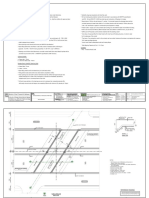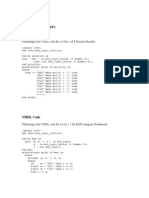Professional Documents
Culture Documents
Reconfigurable Three-Phase SPWM Implementation On De2 Fpga: Ahmed Belkheiri, Said Aoughellanet, Mohammed BELKHEIRI
Reconfigurable Three-Phase SPWM Implementation On De2 Fpga: Ahmed Belkheiri, Said Aoughellanet, Mohammed BELKHEIRI
Uploaded by
ANDRES CAMILO HERRERA OSORIOOriginal Description:
Original Title
Copyright
Available Formats
Share this document
Did you find this document useful?
Is this content inappropriate?
Report this DocumentCopyright:
Available Formats
Reconfigurable Three-Phase SPWM Implementation On De2 Fpga: Ahmed Belkheiri, Said Aoughellanet, Mohammed BELKHEIRI
Reconfigurable Three-Phase SPWM Implementation On De2 Fpga: Ahmed Belkheiri, Said Aoughellanet, Mohammed BELKHEIRI
Uploaded by
ANDRES CAMILO HERRERA OSORIOCopyright:
Available Formats
Ahmed BELKHEIRI1,2, Said AOUGHELLANET1, Mohammed BELKHEIRI2
Department of Electronic Engineering, University of Elhadj Lakhdar, Batna 05000, Algeria(1),
Laboratoire de Télécommunications, Signaux et Systèms, University of Amar Thelidji, Laghouat 03000, Algeria(2)
Reconfigurable three-phase SPWM implementation
on DE2 FPGA
Abstract. The purpose of this paper is to design and implement a modified strategy in traditional three phase SPWM technique based on Cyclone
II ALTERA FPGA to be used for variable voltage and frequency AC supplies with high resolution to cover a required range of v and f, with
customizable SPWM characteristics such as modulation index, carrier frequency, modulating signal frequency and delay time (dead-time). The
design entry is achieved using Quartus II software through schematic and VHDL description language tools. By using the Altera DE2 development
and education board the proposed architecture has been implemented and tested. Behavioural simulation and experiment results are successfully
achieved showing that the proposed SPWM signal generation strategy works properly and can reduce the usage of logic elements (LE).
Streszczenie. W artykule opisano implementację zmodyfikowanej techniki modulacji sinusoidalnej PWM dla trójfazowych zasilaczy AC o
regulowanym napięciu i częstotliwości. W badaniach wykorzystano platformę DE2 z układem FPGA Cyclone II firmy Altera. Wyniki symulacyjne i
eksperymentalne potwierdzają skuteczność działania i redukcję wykorzystania zasobów układu. (Implementacja rekonfigurowalnej, trójfazowej
techniki SPWM na platformie DE2 z FPGA).
Keywords: FPGA, SPWM, VHDL, logic elements (LEs).
Słowa kluczowe: FPGA, SPWM, VHDL, elementy logiczne (LEs).
Introduction number of gates in a subset of the design and may be
Field programmable Gate Array (FPGA) devices are device specific [5].
aimed in the implementation of high performance, large The SPWM technique that was introduced in [6], use 841 of
size circuits, thanks to the speed advantage of direct logic elements, fixed carrier frequency and 1 Hz step to
hardware execution on the FPGA, low volume applications, adjust the modulating frequency, in the references [1, 4, 7,
particularly for applications that can exploit customized bit 8] the modulating frequency of SPWM is fixed at 50Hz and
widths and massive instruction-level parallelism. An even the design is limited to two levels of modulation index which
more, another important issue in using FPGAs is their re- are set at 0.5 and 0.75. in [8] however in our design all the
configurability and reusable hardware architectures for rapid characteristics of SPWM can be adjusted and reconfigures,
prototyping of the digital system [1]. by 0.5 Hz step for modulating signal frequency and by
The Cyclone FPGA’s logic array consists of LABs, with exactly 0,78% step for amplitude level thanks to the used 8
10 Logic Elements (LEs) in each LAB. An LE is a small unit bit data signed format. In addition to that, both carrier
of logic providing efficient implementation of user logic frequency and dead time can be chosen from the user
functions. LABs are grouped into rows and columns across corresponding to power switches characteristics used in the
the device. Cyclone devices range from 2,910 to 20,060 application.
LEs [2].
In many applications we need to control both the Principle of Sine SPWM
magnitude and frequency output voltage or current, for Consider the single-phase half-bridge [9] (fig.1.a)
example an AC frequency converter is designed to control comprising two complementary switches K1 and K’1
both the voltage and frequency fed to the motor to adjust supplying a voltage (Va -Vo) equals to +U/2 or –U/ 2. In
speed of the machine, the voltage sourced inverter is PWM [9], the points of turning K1 and K’1 are determined by
another example where the input DC voltage is essentially the intersections of:
constant in magnitude and the AC output voltage has Reference wave (Va -Vo)w representing the wanted
controlled in magnitude and frequency. signal with a frequency fr .
The pulse width modulation strategy is proven to be Modulation or carrier wave M, with a frequency fc with
the most adapted technique for the controlled inverter while a triangular shape and of amplitude U/ 2 (fig.1.b)
it has large range of the output voltage and frequency, and
low total harmonic distortion (THD)[3,4].
The PWM technique implementation has been the
subject of intensive research using different digital
techniques based on microprocessors, micro-controllers
and Digital signal processors (DSPs). Recently some
researches were conducted in generating SPWM with
FPGA. As among primary physical characteristics of a
digital design is the area covered by the system ,
subsequently, we have to design full adjustable SPWM IC
by entering the reference inputs related to required
modulating and carrier frequency with high resolution,
further with less number of logic elements(LEs) utilization.
We will concentrate in this paper on area reduction based
on choosing the correct topology. Topology refers to the
higher-level organization of the design and is not device
specific. Circuit-level reduction as performed by the
synthesis and layout tools refers to the minimization of the Fig.1. a) Single-phase half-bridge; (b) PWM generation
144 PRZEGLĄD ELEKTROTECHNICZNY, ISSN 0033-2097, R. 89 NR 2a/2013
The equation of rising M Part:
U t
(1) M 2U
2 Tc
The intersections of (Va -Vo)w with rising M at t1, such as
U Tc
(2) t1 Va V0 w
2 2U
Determine the points at which K’1 is turned on and
hence the start of the periods where (Va –Vo) equals –U/2.
3U t
M 2U
(3)
2 Tc
The intersections of (Va-Vo)w with falling M at t2, such a
Fig.2 SPWM technique; PWM high pulse and low pulse; output
voltage
3U T
t2 Va V0 w c
(4) 2 2U Specifications
The three phase SPWM unit is designed to generate six
Determine the points at which K1 is turned on and output pulses (two signals per phase) adjusted in both index
hence the start of the periods where Va –Vo equal +U/2. If modulation, carrier modulating sine frequency with 0:5Hz
fc is much greater than fr , voltage Va –Vo remains almost step (highest possible resolution), but with a phase angle
constant during a cycle Tc of carrier wave, the examination 120o_ between pairs, and an appropriate delay time must
of fig. 1.b easily shows that the average value of Va –Vo, in be inserted between each two complementary
this cycle is pulses(PWM_H and PWM_L) to prevent short circuit
problem and power converter breakdown.
1U
(Va V0 ) av
Tc 2
Tc t2 t1 The proposed SPWM architecture
(5) The block diagram of the proposed architecture is
Replacing t1 and t1 by their values, we get shown in Fig. 3. The data inputs are three 8-bit data word,
the first (frequency_ref) refer to the modulating wave
(Va V0 ) av (Va V0 ) w frequency the second (Amplitude_ref) refer to the
(6) modulation index ma, and the last corresponding to the
frequency carrier, so it can be easily interfaced to a FPGA
So if the reference varies sinusoidally, the average value of development DE2 board (IO port pins). The top module
(Va -Vo) varies in the same way. The aim is to approximate shown in fig. 3 is divided into sub-modules:
sinusoidal output voltages by sinusoidally varying their Three identical modules to generate three sine waves
0
average values. The basic idea to produce SPWM shifted between them with 120 , which are used as
switching signals consists to compare between the sine modulating signals, each signal is generated by using an 8
reference signal Vr and the triangular carrier signal Vc, bit free running counter point to the memory that contains a
which is clearly illustrated in Fig.2. If the reference is 256 samples of a the sine wave, that represented as 8 bit
sinusoidal, two parameters characterize the modulation [9]: signed fractional format (-1 to + 1 of amplitude).
The modulation index or regulation factor ma; this is the
ratio of the amplitude of the reference to the peak value
of the carrier wave :
Vr
ma
(7)
Vc
The frequency modulation index mf ; this is the ratio between
the carrier and reference frequencies:
fc
mf
(8)
fr
Since the turn-off time of power devices is usually longer
than its turn-on time, and therefore, an appropriate delay
time named (dead-time) must be inserted between these
two gating signals of the two complementary switches to
avoid the short circuit. The length of this delay time is
usually about 1.5 to 2 times the maximum turn-off time [10]. Fig.3 Block diagram of SPWM Strategy
PRZEGLĄD ELEKTROTECHNICZNY, ISSN 0033-2097, R. 89 NR 2a/2013 145
The frequency of the generated waveform can be 4% of memory bits, 13% of pins, 0% of PLLs unit are
controlled by the clock of the pointer counter. Hence a needed to implement this circuit on the selected FPGA
configurable sub-module is designed to generate adequate device.
clock frequency, in this research this sub module is
configured to generate rang frequency sine wave (0.5 to 60
Hz) related to the entered Frequency_ref, since almost all
the industrial motors work at 50/60 Hz as shown in figure 4.
Fig.4 Generation the sine wave adjusted in frequency
Fig.5 Top level entity of SPWM generator
The value of frequency_ref is determined by the
following formula:
FFPGA
Frequency ref 2
(9)
2 N .Fw
where: Fw is desired sine wave frequency, FFPGA is the
FPGA board clock frequency (27 MHz in this work), N is
the data width of counter (8 in our case).
Using the previous formula to calculate and store all
Frequency_ref values in memory in order to generate the (1
to 60Hz) frequency rang. Another specification should be
achieved is scaling the generated sine wave amplitude
related to amplitude_ref (0 to 1 by requested step). To
perform this operation, two fixed point arithmetic operation
are used; the multiplication and the division which is carried
easily by shift operation.
In this approach, each 8 bit data sine wave sample is
Fig.6 Compiler flow summary
read from the memory then it is multiplied by the entered
amplitude_ref, the result is a 16 bit data signed which again
In order to verify the design functionality, 27 MHz is
shifted 7 times (division by 127), finally the result is
used as main clock frequency in simulation. Figures (7, 8, 9,
converted into 8 bit signed data format. This approach
and 10) show the functional simulation results with different
allows us to scale the sine wave between 0 and 0:992 by
entered specification. We can see that the three shifted
0.0078 step which represents 0.78%.
modulating sine wave and carrier triangle wave are
The carrier waveform is a triangle wave that was
successfully generated. In figure 7 and figure8 the time
implemented in FPGA like an up-down counter, with same
cursors indicate 16.6127 ms (60Hz) , the zoom area of two
way described in previous paragraph we can generate the
complementary pulses shows that the dead time is properly
carrier waveform with desired frequency related to the
inserted and by careful examination of the pulse widths in
carrier_ frequency_ref input.
both figures 7 and 8 it is very clear that the pulse widths are
The deadbeat time insertion was embedded after the
changed by varying the modulation index from (98.4%to
outputs of the comparators. Every comparator output and
62.9%). Since the carrier frequency in figure 8 is 1.35 KHz
its complement are subject to an adjustable delay when
and in figure 9 is 450Hz, the number of pulses by one cycle
they switch from logic ’0’ to logic ’1’. The deadbeat time can
in each figure is different.
be adjusted by controlling the clock which is used to trigger
the dead time system. With these approaches any desired
Experimental results
specification can be easily achieved.
The Cyclone device is configured by loading internal
static random access memory (SRAM). Since SRAM is
Functional simulations Results
used in FPGAs, the configuration will be lost whenever
The designed SPWM top module has been developed
power is removed, so the active serial programming is
and implemented by using the Altera DE2 development and
activated which means that the configuration of bit stream is
education board, which include Cyclone II 2C35 family
downloaded into the Altera EPCS16 serial EEPROM chip. It
EP2C35F672C6 FPGA devise in a 672-pin package, and
provides non-volatile storage of the bit stream, so the
EPCS16 serial configuration device using Quartus II
information is retained even when the power supply of the
software provided by Altera. The figure 5 shows the top DE2 board is turned off. When the board’s power is turned on,
level entity of SPWM which is developed by using the configuration data in the EPCS16 device is automatically
schematic and vhdl description language.
loaded into the Cyclone II FPGA [2, 12].
The entered design is synthesized into a circuit that
consists of the logic elements (LEs) provided in the FPGA
chip. The Fig. 6 displays the compiler flow summary
section, which indicates that only 2% (607) logic element,
146 PRZEGLĄD ELEKTROTECHNICZNY, ISSN 0033-2097, R. 89 NR 2a/2013
Before programming the FPGA a pin assignment should
be performed, so two debounced pushbuttons is used to
increase and decrease the modulating wave signal
frequency, four toggle switches to enter the carrier
frequency, another eight switches to adjust the modulation
index. The dead time is chosen by using a generic object in
VHDL code, the six output pulses of SPWM are assigned to
six pins of expansion headers with 3, 3 V output voltages,
27 MHz oscillator clock input is chosen as main clock for
designed system. Figure 11 shows the hardware setup(PC,
DE2 board and Tektronix oscilloscope) used in this
experimental study to check the configurability and the real
Fig.7 Functional simulation results, frequency_ref=60Hz, time operation of the design.
amplitude_ref=0.984, carrier frequency 1.35 kHz
Fig.11 Hardware setup
Figures 12, 13, and 14 show the two complementary
(PWM_H1, PWM_L1) SPWM pulses related to 1, 1.5 and
Fig.8 Functional simulation results, frequency_ref=60Hz, 10Hz reference modulating frequency respectively, where
amplitude_ref=0.629, carrier frequency 1.35 kHz the carrier frequency is set to 450Hz and the modulation
index is set to 98.4%. The red square waveform, which
envelope the blue PWM_H1 pulse, is generated to measure
the frequency of modulating signal.
Fig.12 Generated complementary pulses with Frequency_ref=1Hz
Fig.9 Functional simulation results, frequency_ref=60Hz,
amplitude_ref=0.984, carrier frequency 450 Hz
Fig.13 Generated complementary pulses with frequency_ref=1.5Hz
Fig.10 Functional simulation results, frequency_ref=40Hz,
amplitude_ref=0.629, carrier frequency 750 Hz
PRZEGLĄD ELEKTROTECHNICZNY, ISSN 0033-2097, R. 89 NR 2a/2013 147
Fig.14 Generated two complementary pulses with
frequency_ref=10.5Hz
Fig.18 Generated 3 high pulses
Fig.15 Generated complementary pulses with amplitude_ref=0.984
Fig.19 Three captured modulating signals using Hi Res acquisition
mode.
The figure 18 shows the three SPWM high pulses
PWM_H1, PWM_H2, PWM_H3. These pulses are identical
o
with the same modulating frequency but shifted by 120 .
The figure 20 is captured using Hi Res acquisition mode
in Tektronix 4000 oscilloscope which can behave as a
demodulator but in high carrier frequency (here it is set at
5.7kHz) with low modulating signal frequency 40Hz. It is
obvious that the three reference modulating signals are
extracted and a phase shift of 120° is present between each
Fig.16 generated complementary pulses with amplitude_ref=0.795 pair of signals. Hence the implemented SPWM module
works properly and can be used for power 3 phase inverter
control for AC machine control.
Conclusion
This paper presents the design and implementation of
adjustable and configurable three-Phase SPWM with high
resolution based on FPGA. A novel approach was introduce
to designing such module in order to reduce the number of
used logic elements (LEs) 607 in our case, 841 in [6], The
constructed SPWM IC can generate a wide range of PWM
output voltages and frequencies with high resolution. The
aim of this hardware design is to contribute and to benefit of
FPGA component in the control of electrical drives and in
power electronic applications, subsequently enrich the
Fig.17 The dead time for turn-on and turn off libraries of predefined complex functions and circuits that
have been tested and optimized to probable reuse and to
The figures 16 and 17 show the same (PWM_H1, speed up the design process employing the FPGA
PWM_L1) SPWM pulses but related respectively to 98.4% technology.
and 79.5% modulation index with 450 Hz carrier frequency
and 40 Hz modulating frequency which explains clearly the Acknowledgments
difference in pulse width, and therefore the duty cycle is The authors would like to acknowledge the contributions of
changed. the head of laboratoire d’ études et Développement des
Figure 17 shows the measured delay between two Matériaux Semi-conducteurs et Diélectriques, LeDMaScD
complementary pulses which is 443ns. This value of Laghouat University for providing the necessary
approximately equals the desired value specified in the hardware and development tools.
design and simulation results 403ns. This little difference of
40ns which is very small is due to the signal propagation
hardware delay.
148 PRZEGLĄD ELEKTROTECHNICZNY, ISSN 0033-2097, R. 89 NR 2a/2013
REFERENCES For Three Phase Inverter, ARPN Journal of Engineering and
[1] N.A. Rahim and Z. Islam, Field Programmable Gate Array Applied Science, 5 (2010),
Based Pulse-Width Modulation for Single Phase Active Power [12] , DE2 Developement and education board user manual, Altera
Filter, American Journal of Applied Sciences 6 (2009) 1742– USA .
1747. [13] E. Koutroulis, A. Dollas, K. Kalaitzakis, High-frequency pulse
[2] J. O. Hamblen, T. S. Hall, and M. D. Furman,Rapid Prototyping width modulation implementation using FPGA and CPLD ICs,
of Digital Systems, Springer 2008. Journal of Systems Architecture 52 (2006) 332–344.
[3] Y. Tzou, nd H.J. Hsu, FPGA Realization of Space-Vector PWM [14] W.A. Salah , D. Ishak , K. J. Hammadi, PWM Switching
Control IC for Three-Phase PWM Inverters, IEEE Trans. On Strategy for Torque Ripple Minimization in BLDC Motor,
Power Electronics 12 (1997) 953–965. Journal of Electrical Engineering- Slovakia 62 (2011) 141–146.
[4] B. Kariyappa, M. U. Kumari, CPWM And SPWM Techniques of [15] S.L. Jung, M.Y. Chang, Jin-Yi Jyang, L.C. Yeh, and Y. Y. Tzou,
Controlling Speed of AC Servomotor Using FPGA, International Design and Implementation of an FPGA-Based Control IC for
Journal of VLSI and Signal Processing Applications 1 (xxxx) AC-Voltage Regulation, IEEE Trans. on Power Electronics 14
26–29. (1999).
[5] S. Kilts ,Advanced FPGA Design Architecture, Implementation, [16] F. Berrezzek, A. Omeiri, A Study of New Techniques of
and Optimization, John Wiley & Sons, 2007 Controlled PWM Inverters European Journal of Scientific
[6] T. Sutikno, M. Facta, An Efficient Strategy to Generate High Research 32 (2009) 77–87.
Resolution Three-Phase Pulse Width Modulation Signal Based
on Field Programmable Gate Array, International Journal of
Computer and Electrical Engineering, 2 (2010) Authors: Mr Ahmed Belkheiri, University of Hadj Lakhdar - Batna,
[7] B. Kariyappa, M. U. Kumari, FPGA Based Speed Control of AC Department of Electronics, Avenue Chahid Boukhlouf, Batna
Servomotor Using Sinusoidal PWM, International Journal of 05000, Algeria,E-mail ahd_belkheiri@yahoo.fr, Dr Said
Computer Science and Network Security 8 (2008), 346–357. Aoughellanet, University of Hadj Lakhdar - Batna, Department of
[8] A. AbuBakar, M. Z. Ahmad and F.S. Abdullah, Design of FPGA Electronics, Avenue Chahid Boukhlouf, Batna 05000, Algeria,E-
Based SPWM Single Phase Inverter, Proc. of Malaysian mail asunibat@yahoo.fr, Dr Mohammed Belkheiri, University Amar
Technical Universities Conference on Engineering and Telidji - Laghouat , Department of Electronics, Laboratoire de
Technology Pahang, Malaysia, June 20-22, 2009. Télécommunications, Signaux et Syst_emes, BP G37 Route de
[9] J. Bonal, G. Seguier, Variable speed electric drives Vol. 2: Ghardaia, Laghouat 03000, Algeria., E-mail mbelkhiri@yahoo.com.
reminders on power and control electronics, electronic variable
speed drives, (Lavoisier publishing, Paris,2000) The correspondence address is:
[10] R.K. Pongiannan I N.Yadaiah, FPGA based Space Vector
PWM Control IC for Three Phase Induction Motor Drive, it Proc. e-mail: mbelkhiri@yahoo.com
3rd Int. Conf. EntityRelationship Approach, 2006, pp 2061-
2066.
[11] K. V. Kumar, P. A. Michael, J. P. John and S. S. Kumar,
Simulation and Comparison of SPWM And SVPWM Control
PRZEGLĄD ELEKTROTECHNICZNY, ISSN 0033-2097, R. 89 NR 2a/2013 149
You might also like
- The Gastritis Healing Book A Comprehensiv - L G CapellanDocument227 pagesThe Gastritis Healing Book A Comprehensiv - L G CapellanJulia Bean89% (9)
- Obstacle Avoidance Robot Using Verilog CodeDocument14 pagesObstacle Avoidance Robot Using Verilog Codecdiyyala50% (4)
- VHDL Code For Digital Clock On FPGADocument6 pagesVHDL Code For Digital Clock On FPGASidney O. EbotNo ratings yet
- Project Plan For Embroidered ArticleDocument5 pagesProject Plan For Embroidered ArticleKim Taehyung100% (1)
- VHDL Simulation of Fir FilterDocument66 pagesVHDL Simulation of Fir FilterSaurabh Minotra67% (3)
- Frequency Estimation by Modulation FFT and MusicDocument4 pagesFrequency Estimation by Modulation FFT and MusicsujanyaNo ratings yet
- VHDL Code For 4-Bit ALUDocument6 pagesVHDL Code For 4-Bit ALUShanaka JayasekaraNo ratings yet
- Spooky2 Guide June 3, 2015 by David BourkeDocument133 pagesSpooky2 Guide June 3, 2015 by David Bourkewhalerocker1100% (2)
- Client: Title:: General Notes of Vehicular Under PassDocument10 pagesClient: Title:: General Notes of Vehicular Under PassPraveen CyssanNo ratings yet
- Public Restroom DesignDocument7 pagesPublic Restroom DesignCheungolNo ratings yet
- VLP 0401 " Space Vector PWM Using FPGA"Document6 pagesVLP 0401 " Space Vector PWM Using FPGA"ashish3179100% (1)
- DSPDocument57 pagesDSPhamidr_karamiNo ratings yet
- Finite State Machine Design Using VHDLDocument8 pagesFinite State Machine Design Using VHDLJoe MannNo ratings yet
- Altera PWMDocument50 pagesAltera PWMEnrique VillaltaNo ratings yet
- Pedroni VHDL 2ed Exercise Solutions v4 PDFDocument37 pagesPedroni VHDL 2ed Exercise Solutions v4 PDFana eht50% (2)
- FpgaDocument99 pagesFpgaBABU MNo ratings yet
- VHDLDocument11 pagesVHDLlizhi0007No ratings yet
- Lab 05 To Perform Signal Companding in SimulinkDocument15 pagesLab 05 To Perform Signal Companding in SimulinkArshad AliNo ratings yet
- MIPS ArchitectureDocument28 pagesMIPS Architectureduong1989100% (1)
- IC 741 Operational AmplifierDocument8 pagesIC 741 Operational AmplifierJed PeriaNo ratings yet
- Project Report - VHDL MUXDocument4 pagesProject Report - VHDL MUXMsdmsd Msd100% (1)
- Power System Simulation Lab ManualDocument41 pagesPower System Simulation Lab ManualgokulchandruNo ratings yet
- VHDL Lab FileDocument48 pagesVHDL Lab FileAnkit Gupta100% (1)
- Arduino UNODocument6 pagesArduino UNOsalmanNo ratings yet
- VHDL Code For LCD DisplayDocument7 pagesVHDL Code For LCD DisplayPraveen VaishnavNo ratings yet
- 4x1 MUXDocument6 pages4x1 MUXYash GuptaNo ratings yet
- Function Generator Using VHDLDocument20 pagesFunction Generator Using VHDLnaveenbabu19No ratings yet
- VHDL Coding For FIR FilterDocument56 pagesVHDL Coding For FIR Filterxxtcxx100% (5)
- Exercices VHDLDocument83 pagesExercices VHDLFadi Akoury50% (2)
- Adaptive Filtering ApplicationsDocument410 pagesAdaptive Filtering Applications花玉良100% (1)
- Implementation of Digital Filter by Using FPGADocument81 pagesImplementation of Digital Filter by Using FPGAisaac200894% (16)
- Practice3 DC Motor Control PDFDocument9 pagesPractice3 DC Motor Control PDFmechernene_aek9037No ratings yet
- Analog Solutions For Xilinx FPGAsDocument36 pagesAnalog Solutions For Xilinx FPGAsestraj1954No ratings yet
- Frequency Divider Using VHDLDocument27 pagesFrequency Divider Using VHDLPallavi NalawadeNo ratings yet
- PLC SFCDocument16 pagesPLC SFCalimoya13No ratings yet
- UART in VHDL and Verilog For An FPGADocument10 pagesUART in VHDL and Verilog For An FPGATrọngHữuNguyễnNo ratings yet
- 8 Bit ALU by XilinxDocument16 pages8 Bit ALU by XilinxDIPTANU MAJUMDERNo ratings yet
- VHDL Programs LabDocument20 pagesVHDL Programs LabVasu SiriNo ratings yet
- Barrel ShifterDocument79 pagesBarrel ShifterVinay Reddy100% (2)
- System For Controlling An Exoskeleton Haptic DeviceDocument39 pagesSystem For Controlling An Exoskeleton Haptic DevicezaracuscaNo ratings yet
- Muscle Sensor v3 Users ManualDocument4 pagesMuscle Sensor v3 Users ManualDaniel IturraldeNo ratings yet
- Sirisha Kurakula G00831237 ProjectDocument12 pagesSirisha Kurakula G00831237 ProjectSirisha Kurakula0% (1)
- A Novel Direct Torque Control (DTC) Method For Five-Phase Induction MachinesDocument7 pagesA Novel Direct Torque Control (DTC) Method For Five-Phase Induction MachinesBook4AllNo ratings yet
- Moore and Mealy MachinesDocument6 pagesMoore and Mealy MachinesNirmal Kumar PandeyNo ratings yet
- GMSKDocument18 pagesGMSKHamza MalikNo ratings yet
- Cd-5-Doc Quadcopter Batch No 30 PDFDocument51 pagesCd-5-Doc Quadcopter Batch No 30 PDFjunaid 786No ratings yet
- PIC16F877ADocument10 pagesPIC16F877ABhaskar Rao PNo ratings yet
- Lec17 FSM PDFDocument27 pagesLec17 FSM PDFNithin KumarNo ratings yet
- Pal and PlaDocument10 pagesPal and PlaRahul Kumar67% (6)
- Vlsi Lab Manual 17ecl77 2020 SaitDocument157 pagesVlsi Lab Manual 17ecl77 2020 Saitsuraj jha100% (1)
- 253 Apl Modbus-Protocol en 140929Document12 pages253 Apl Modbus-Protocol en 140929MOHAMED ABDELMALEKNo ratings yet
- Vlsi Project Report Arithmetic Logical Unit Using Verilog AluDocument7 pagesVlsi Project Report Arithmetic Logical Unit Using Verilog AluAnurag KharwarNo ratings yet
- Driving Relays With stm32f407vgtx Microcontroller Using Uln2003 Relay DriverDocument12 pagesDriving Relays With stm32f407vgtx Microcontroller Using Uln2003 Relay DriverAnonymous Nlaa5HNo ratings yet
- System Identification, Estimation and FilteringDocument34 pagesSystem Identification, Estimation and FilteringDao AnhNo ratings yet
- Application-Specific Integrated Circuit ASIC A Complete GuideFrom EverandApplication-Specific Integrated Circuit ASIC A Complete GuideNo ratings yet
- Digital Design of Signal Processing Systems: A Practical ApproachFrom EverandDigital Design of Signal Processing Systems: A Practical ApproachRating: 5 out of 5 stars5/5 (1)
- Electrical Engineering Laboratory V Course Code: Epo662: Simulation of Three-Phase Inverter With A PWM Control EPO662Document5 pagesElectrical Engineering Laboratory V Course Code: Epo662: Simulation of Three-Phase Inverter With A PWM Control EPO662Danial AkramNo ratings yet
- Inverter and SV-PWMDocument5 pagesInverter and SV-PWMcoep05No ratings yet
- FPGA Implementation of Unipolar SPWM For Single Phase InverterDocument6 pagesFPGA Implementation of Unipolar SPWM For Single Phase InverterMalay BhuniaNo ratings yet
- Psim SVMDocument9 pagesPsim SVMNarendra ReddyNo ratings yet
- H09344448 PDFDocument5 pagesH09344448 PDFslimabidNo ratings yet
- Pulse-Width-Modulation DC Chopper Using Labview SoftwareDocument5 pagesPulse-Width-Modulation DC Chopper Using Labview SoftwareFlorin LațcuNo ratings yet
- Wavelet 5Document6 pagesWavelet 5shantanuNo ratings yet
- Portal RuangDocument17 pagesPortal Ruangade azimaNo ratings yet
- BLD3314HC - Pei Alternator Conditions of Use 0419Document2 pagesBLD3314HC - Pei Alternator Conditions of Use 0419FARLEY ELETRO INDUZIDOSNo ratings yet
- Mankind Is Responsible For The Large Loss of Biodiversity in NatureDocument2 pagesMankind Is Responsible For The Large Loss of Biodiversity in NatureHarold CantosNo ratings yet
- RTL Design Flow: Technology Dependent Logic OptimizationDocument32 pagesRTL Design Flow: Technology Dependent Logic OptimizationNishanth BaratamNo ratings yet
- Effect of Yogasana On Digestive SystemDocument7 pagesEffect of Yogasana On Digestive SystemMaria ArevaloNo ratings yet
- Weight of M.S. PipeDocument14 pagesWeight of M.S. PipeRajat BaghelNo ratings yet
- Problems of Foam Glass ProductionDocument2 pagesProblems of Foam Glass Productionmohamadi42100% (1)
- Kuesioner SDKI 2012Document135 pagesKuesioner SDKI 2012iksanatun_fadil5814No ratings yet
- Beginners Chest Workout 4 Exercises For Building Bigger PecsDocument7 pagesBeginners Chest Workout 4 Exercises For Building Bigger Pecsfella quiNo ratings yet
- SorderaDocument105 pagesSorderaAzís Humberto Gastelum ZatarainNo ratings yet
- Aspiradora Daewoo Rc805Document45 pagesAspiradora Daewoo Rc805chevistarNo ratings yet
- Historical Background Bds 2Document63 pagesHistorical Background Bds 2Ranjan Sharma0% (1)
- Pre Finals Manacc 1Document8 pagesPre Finals Manacc 1Gesselle Acebedo0% (1)
- Grade 4 Supplement: Set D1 Measurement: Weight & MassDocument26 pagesGrade 4 Supplement: Set D1 Measurement: Weight & MassJulioEzequielMartinezNo ratings yet
- The Building and Other Construction WorkersDocument2 pagesThe Building and Other Construction WorkersShreejith100% (1)
- Inclusion of Water Hyacinth Meal in Broiler Chicken Diets: Potential On The Production Performance and Cell-Mediated ImmunityDocument11 pagesInclusion of Water Hyacinth Meal in Broiler Chicken Diets: Potential On The Production Performance and Cell-Mediated ImmunityKeiven Mark Bigtasin AmpodeNo ratings yet
- Flute PhysicsDocument12 pagesFlute PhysicskrumiaaNo ratings yet
- Chemistry AlcoholsDocument44 pagesChemistry AlcoholsSayan Kumar KhanNo ratings yet
- Necromancy Reference For ManualDocument2 pagesNecromancy Reference For ManualTiberio RumaNo ratings yet
- AGN 018 - Regenerative Loads & Reverse PowerDocument4 pagesAGN 018 - Regenerative Loads & Reverse PowerolumideNo ratings yet
- K200 Installation ManualDocument9 pagesK200 Installation ManualDilton AntonioNo ratings yet
- Information From Various Sources - Almanac - Encyclopedia: Quarter 2, Week 3, Day 3Document13 pagesInformation From Various Sources - Almanac - Encyclopedia: Quarter 2, Week 3, Day 3Toni Rose Rafon BenitezNo ratings yet
- 5E Rogue - The Ninja Mage (7502949)Document5 pages5E Rogue - The Ninja Mage (7502949)Cary Hamilton100% (3)
- Bolt Vessel ListDocument2 pagesBolt Vessel Listfarkli88No ratings yet
- TranspirationDocument3 pagesTranspirationKENNETH POLONo ratings yet

























































































